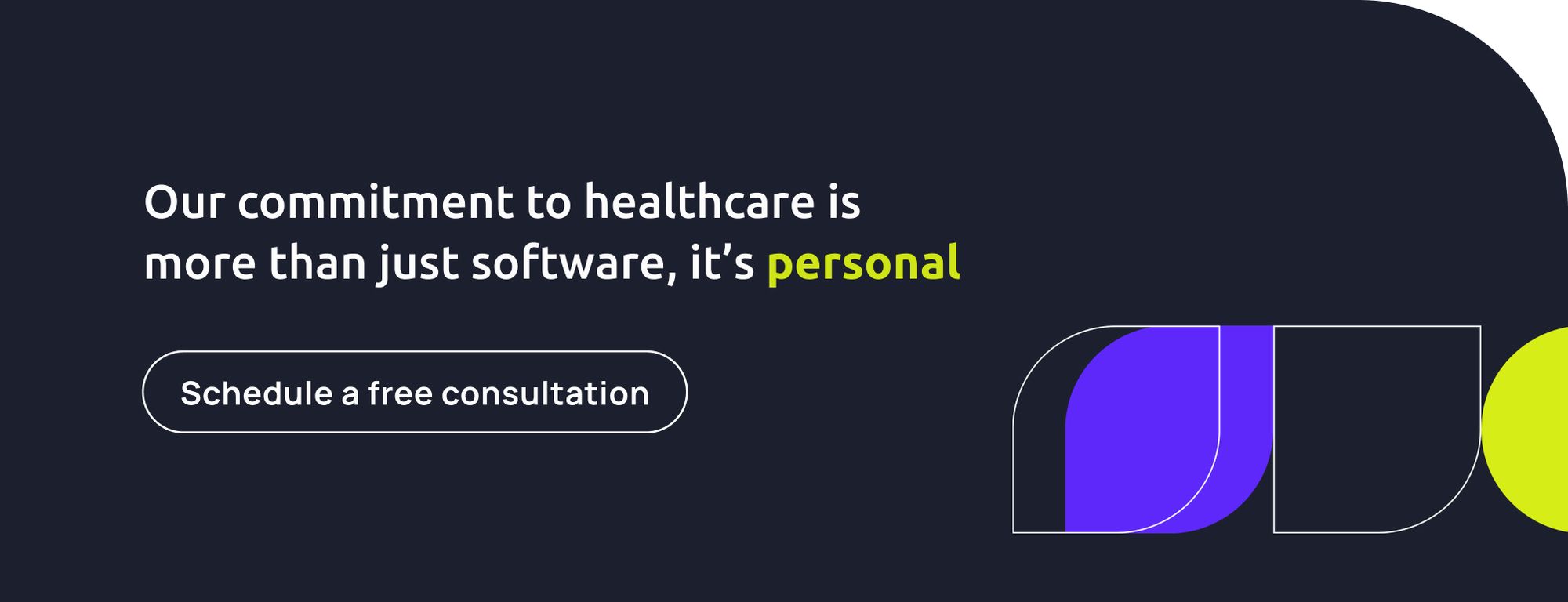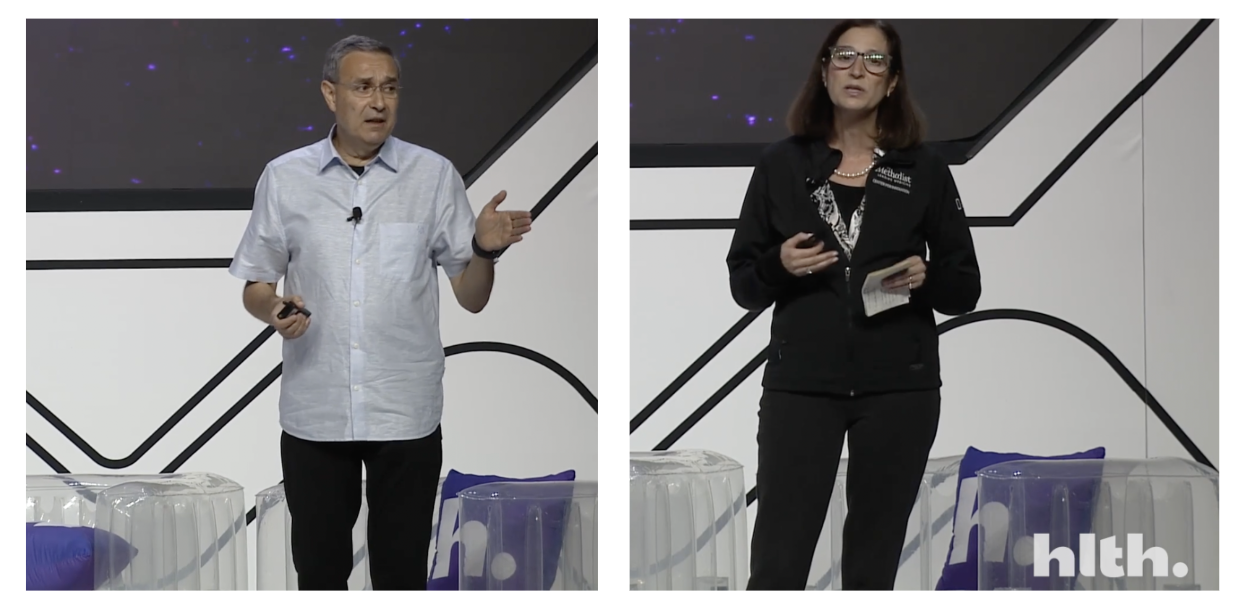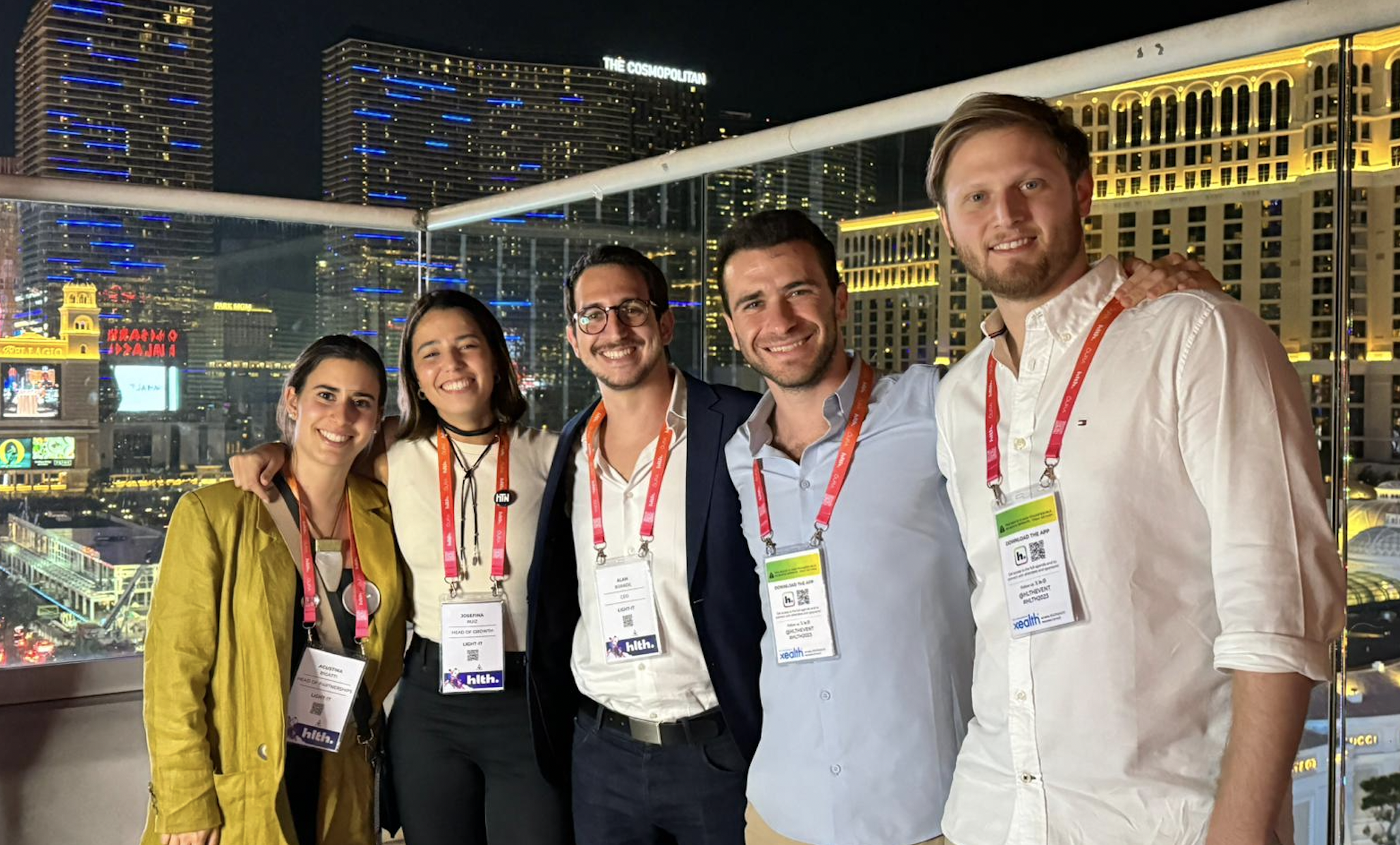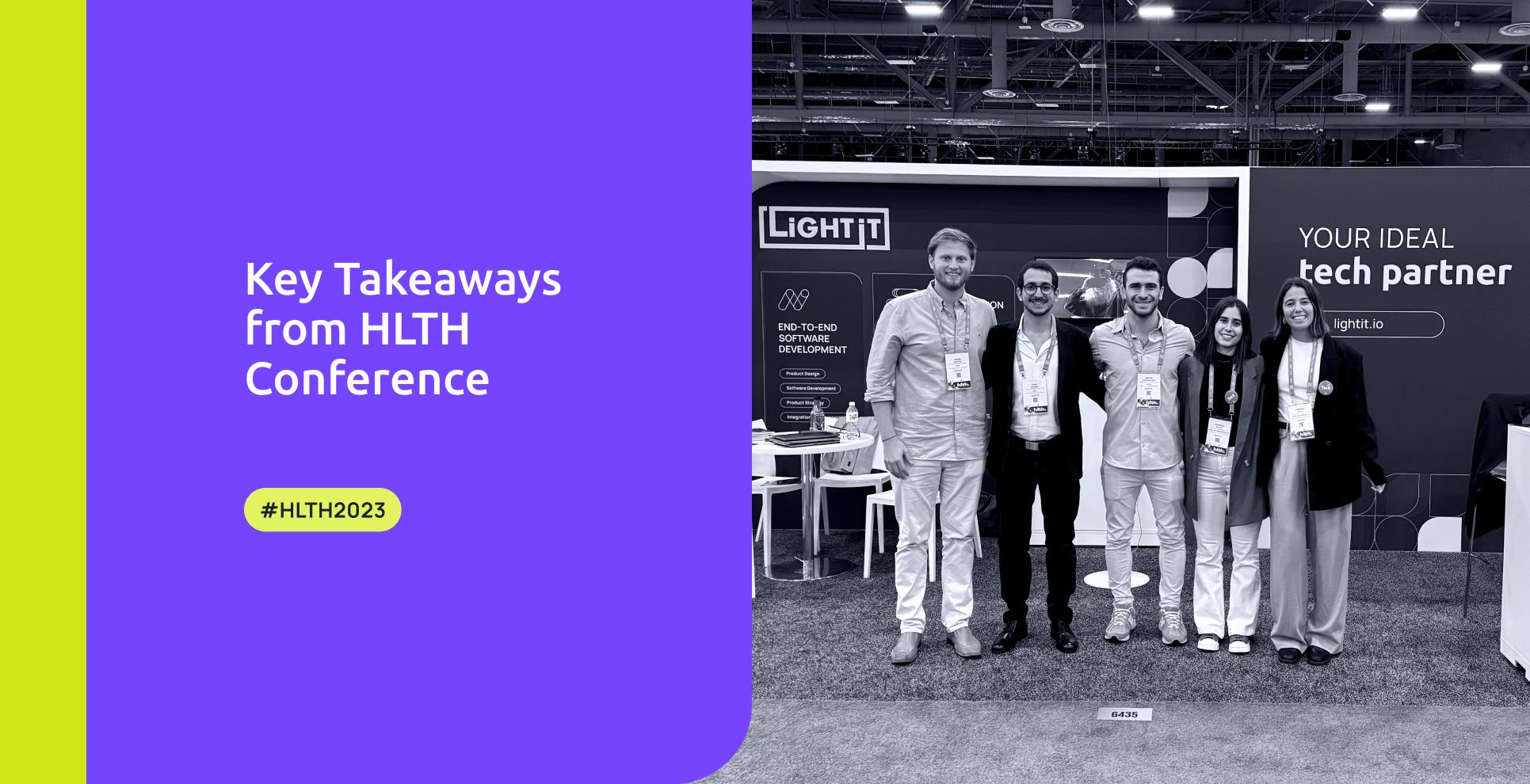Key takeaways from the world's largest healthcare innovation event
HLTH created, once more, a unique experience for the healthcare community, leading the discussion and creation of a better health ecosystem. Our team joined the 10,000+ attendees to be part of the major healthcare innovation event in Las Vegas. And, let us tell you, it really surpassed our expectations.
The agenda was extensive, which made it impossible to cover comprehensively! Besides, this post will highlight new approaches and concepts we took away from our past week.
Innovation in Healthcare
The future is unpredictable and, to be honest, frightening, but our sector is tough and resilient, and we have cutting-edge technologies on our side.
The wellbeing of our clinicians was one of the main topics addressed by the various panels as an urgent issue within the healthcare industry. The toll is real and has been so significant over the last few years (post-pandemic especially) that many professionals have either already left or are contemplating leaving their roles.
A shared ambition: to make affordable, proactive and accessible care a reality
Hemant Taneja (General Catalyst); Marc Harrison, MD (Health General Catalyst)
According to the panel, failures in the healthcare system happen millions of times a day in the us. “So, we need to go from healthcare to health. The best way to deliver health is to have all the incentives aligned, most importantly between the clinicians and the patient,” said Marc Harrison.
The way to do that for the two speakers is to have a fully capitated model to demonstrate maximum creativity and application of resources to keep people out of the emergency department and out of the ICU. For both speakers, it really depends on the digital transformation. But digital has to be a tool in the toolbox. It's not the “be-all”. It's about a click-and-mortar mechanism that has both online and offline operations. We should have AI crawling in EMRs to identify early signs of diseases so as to prevent them. And this is happening, but it happens in very few places in the US; almost never happens for poor people. We need to use technology in the best interest of humanity and deliver it holistically and humanely by great clinicians.
Taking Patient Experience to New Heights
Nick Jonas Nick Jonas (Beyond Type 1); Teri Lawver (Dexcom); Nicholas St. Fleur (STAT).
Healthtech companies have so much more at stake than a typical consumer tech brand: patient lives. That means these companies need to work together with their customers to guarantee that every product component, feature, and development choice is designed with them in mind.
Dexcom Chief Commercial Officer Teri Lawver and singer and health advocate Nick Jonas shared their journeys to diabetes leadership from both sides of the coin: as patients and entrepreneurs. Joined by STAT journalist Nicholas St. Fleur, the pair discussion was insightful:
- The WHY behind their shared mission to bring diabetes conversations to new heights:
"I hope that by creating something new for diabetes, I help patients feel they are not alone and are more connected to a global community that experiences real challenges daily. We’ve got to share our experiences. I'm trying to be a spokesperson for diabetes, an incredibly challenging and unpredictable disease... Some days are tough, and this puts us in a vulnerable place... We've done work to put this conversation on the table. Amplifying the topic has a bigger effect than we realize. For instance, it can enhance research funding and product discovery. To see that I am able to stand in a community super odd for me to put something like diabetes on the table, there’s my WHY", Nick Jonas expressed. - How to manage raising awareness and accessibility:
“We need to continue to partner to bring all the evidence needed so that insurance companies can make the right decisions to cover treatments with new technology to all the ones who need it,” Teri Lawver.
“When we talk about state-of-the-art technology, as good as the tech is great, if you can’t afford it and can’t access insurance, it’s useless,” Lawver expressed. So, the most important thing to understand for the ones who need and provide this tech is the “out-of-pocket” cost. This is the direct payment of money that won’t be later reimbursed. All members of the health ecosystem need to work to bring that number down. For example, in the US this cost is 20 dollars a month. Companies and organizations working with the public administration continue to lower this price. That's leading the way to more affordable health.

AI and Generative AI applied to Healthcare
AI-native startups have made substantial inroads into the healthcare sector this year.
The AI hype cycle promises a wild ride, and health investors are quite eager to participate. The healthcare AI market is expected to reach over $102 billion by 2028, resulting in a torrent of new solutions claiming to have the ability to transform our dysfunctional industry. In a drying-up funding environment, AI has been our life source. So, will the roller coaster ride end, or do we have a long road ahead of us?
Across the US, hospitals and nursing homes are experiencing major personnel shortages. By 2034, we could face a shortage of up to 124,000 physicians; for nurses, that number is even higher, with over 600,000 estimated to leave the profession by 2027. The demand for healthcare professionals, ranging from caregivers to internists to psychiatrists, is increasing. Still, supply is decreasing due to factors such as burnout, working conditions, political intervention, and remuneration. And this is to mention a few.
Artificial intelligence and automations have stepped in to fill workforce vacancies and expedite administrative processes. Burnout can raise the risk of medical errors and malpractice, decrease patient satisfaction, and prevent healthcare staff from developing interpersonal relationships with their patients.
As you see, the need for technological innovation to aid this crisis is latent. In truth, Generative AI has the potential to augment 40% of healthcare working hours, freeing up valuable time for an already overloaded workforce. This won’t address all of our difficulties, but it will at least give a break to many people in the field.
The AI Hype Cycle Coaster
Brigham Hyde, PhD (Atropos Health); Ellie Wheeler (Greycroft); Lu Zhang (Fusion Fund); Neal Khosla (Curai Health); Prateesh Maheshwari (Maverick Ventures).
These five experts dived into all the factors at play to determine if this trend of optimism on AI is warranted or if the doubts will prevail.
Overall, the panelists believe that, while AI has promising implications in healthcare, numerous factors must be considered. They identified key points to validate the efficiency and adoption of AI in the healthcare industry:
- The idea of the human-in-the-loop AI method, including a human overseer to improve accuracy and efficiency.
- Training AI on perfect data doesn't ensure successful application in real-world scenarios. Constant and consistent training, based on various and diverse datasets, is key to diminishing eros and bias.
- There’s a need for evidence and research papers to show the effectiveness of AI.
In addition, they listed the steps to follow to thoughtfully implement AI into existing workflows.
- Training and educating medical professionals to deal with AI tools.
- Carefully evaluating which AI solution fits best for the healthcare provider, taking into account distributional benefits and the potential risks of subscribing to a single tech company.
- Panelists also pointed out that healthcare education and clinical abilities will need to evolve in order to embrace AI.
Generative AI's Lasting Impact on Healthcare
Julia Chapin (Abridge); Nisha Mehta, MD Physician (Side Gigs).
Chapin and Mehta also examined all of the variables to see if this tendency of high optimism is justified or if those who are skeptical will prevail. Some of their insights were:
- The technology is not designed to replace clinicians. The goal is to relieve them from administrative work, thus reducing burnout and allowing them to focus more on patient care.
- There’s a need to debunk AI and make it easier to verify AI-generated data for the sake of trust.
- Openness and willingness to take on the regulatory and privacy issues that arise when integrating AI into healthcare workflows are critical.
ChatGPT vs. The Experts
Brigham Hyde, PhD (Atropos Health); Fatima Paruk MD, MPH (Salesforce); Sonya Makhni (Mayo Clinic); Morgan Cheatham (Bessemer Venture Partners)
We've heard enough about GenAI being more accurate and empathetic than clinicians. This session aimed to put it to the test and settle the debate once and for all. ChatGPT took the stage alongside three health data experts to answer questions about a mock clinical scenario. The speakers evaluated the responses for accuracy and bias and dug into the true potential of AI to fundamentally change clinical practice.
The three healthcare informaticians acknowledged the existing issues in model evaluation and emphasized the need for more steps in testing these models to ensure they are safe, effective, and not causing harm.
They also pointed out the importance of transparency in AI applications in healthcare. The panelists conclude that all models should not be held to the same standards, as some use cases have different risks and requirements. They urge that AI should be developed with patients and healthcare professionals to ensure value and longevity and that there's a need for multimodal, longitudinal, diverse datasets for AI training. This to ensure the data contemplates varied patient profiles and to prevent keeping part of the population outside the testing and training.
Bringing AI to Healthcare Responsibly
Erin Brodwin (Axios); James Manyika (Google).
Manyika, Google's VP of Research Technology and Society, explained how they are managing the natural conflict between the speed of innovation and accountability across generative AI and Google's health portfolio while bringing in varied viewpoints.
He emphasized Google's obligation to get AI in healthcare right in response to the large volume of health-related questions their search engine receives on a daily basis. Google's significant research in AI, particularly in uncovering protein structures and genetic defects that could revolutionize healthcare, was addressed. According to Manyika, they have taken significant measures to protect privacy, including not keeping customer data and committing to HIPAA-compliance.
Manyika also indicated that AI applications are no longer entirely reliant on personal data but rather on patterns in images and datasets. Despite considerable advances in AI, he lastly highlighted the importance of taking responsibility for leveraging AI's potential in healthcare, focusing on reducing risks and optimizing benefits.
Deploying Clinical AI at Scale

Nassib Chamoun (Health Data Analytics Institute); Roberta L. Schwartz (Houston Methodist Hospital).
Houston Methodist Hospital's Roberta Schwartz, Chief Innovation Officer, discussed how a large quantity of healthcare data housed in electronic health records (EHRs) may be taken advantage of for better patient management. They explored the challenges tied to the use and accessibility of EHRs, which are mostly unstructured and often redundant.
This Methodist Hospital employs generative AI to integrate and combine raw clinical notes with structured data. This aims to improve documentation and provide doctors with continuously updated, transparent, and actionable risk profiles by integrating HDAI's platform into their Epic EHR system. Now, their clinicians spend less time searching for information and more time developing individualized treatment plans and personally connecting with their patients.
Naseeb demonstrated the Health Data Analytics Institute's method for transforming enormous amounts of structured and unstructured healthcare data into useful insights. Using machine learning and generative AI models on cloud computing infrastructure enables effective data processing. For instance, the models analyze clinical notes in real-time, enabling the prediction of patient risk profiles from past data. These insights empower healthcare teams to deliver more efficient treatment and care to their patients. However, this requires a significant cultural shift towards a more data-driven healthcare system.
Digital Healthcare
Data Rx
Lisa Shah, MD (Twin Health); Noosheen Hashemi (January AI); Paul Jacobson (Thorne HealthTech); Stephen Ranjan (Roche); Lina Behrens (HLTH Europe).
The presentation started with the premise: “Let thy data be thy drug!”
Emerging as a powerful tool to drive informed health decision-making, the potential of data to revolutionize healthcare beyond traditional medicine is happening now. Day-to-day health data is being leveraged for timely disease identification and improving patient longevity. Wearable technology optimization and data-driven clinical analysis can produce insights and knowledge to increase the effectiveness and efficiency of care. However, there are still obstacles to be solved in these areas.
The panelists share their views on the importance of data in managing and preventing health issues, emphasizing the potential of wearable technologies and Artificial Intelligence to contribute significantly.
- They noted the importance of integrating therapeutic diagnostics and data with the potential for powerful interventions that reduce harmful events and improve patient outcomes.
- Also discussed how data can give patients the tools to make more informed health management choices, advocating for the use of wearables and AI in achieving this.
- The discussion also highlights the shift taking place in the role of doctors and the healthcare system, the focus is and providing patients with actionable data for self-management.
- Some panelists expressed concern that the effectiveness of wearables is overrated, indicating that more work is needed to ensure these devices lead to substantial behavioral changes.
Healthcare, Everywhere, All at Once
Caitlin Donovan (Uber Health); Nworah Ayogu (Amazon Pharmacy); Robina Verbeek (SOS); Marisa Bass (Primary Venture Partners); Aaron Severs (DocGo).
Healthcare services are aiming to be as easy to locate and access, just as Starbucks. So why not put them in, well, a Starbucks? While the coffee giant is not quite in the healthcare game yet, many of our nation's top retail chains and tech companies have jumped into care delivery. Physical and digital locations where people naturally spend their time are prime avenues to deliver health services and close gaps in access for patients who’ve been historically underserved. Greater optionality in how a person receives care will lead to an enhanced accessibility, more personalization, more innovation, and more transparency. Care how you want it, when you want it!
Many times, being non-traditional is a good thing.
Mental Health
Mental health crisis is now identified as the 'Crisis of our Time’. And the figures are alarming -to say the least- more than 1 in 5 US adults are currently living with a mental illness, and over 60% of adolescents with serious depression aren't receiving treatment. As healthcare leaders and stakeholders grapple with these challenges, breakthroughs in technology and AI, revamped care delivery models, and innovative digital interventions pave the way to better care accessibility.
Technology is crucial to unlocking the digital front door to address the Mental Health Crisis.
The Line of Defense Against Suicide Panel
Panelists: Dr. Shairi Turner - Crisis Text Line; Myra Altman, PhD - Brightline; Nova Bright -The Trevor Project; Seth Feuerstein, MD, JD - Yale University and Oui Therapeutics
The troubling rise in suicide rates in the US and the challenge of combating this health crisis were the main focus of this discussion. Experts on the panel highlighted shocking statistical trends, including that suicide is the second leading cause of death for teens and young adults aged 12 to 25, indicating a 40% growth since 2011. The panelists recount factors driving this trend:
- Unequal access to care
- Stigmas associated with mental health treatment
- Increasing shortage of mental health providers
- Lack of mental health screening and early intervention
So, what do they propose?
- Seth Feuerstein, Yale University and Oui Therapeutics, called for a specialized field of "suicidology" to ensure proper training and treatment of suicidal patients, similar to specialized fields in oncology.
- Nova Brite, from The Trevor Project, expressed that fighting the systemic prejudices and biases towards mental illnesses and highlighting the impact of politicizing identities, especially for marginalized communities.
- Myra Altman, from Brightline, proposed the implementation of diversified and culturally competent health practitioners.
Higher quality and more trustworthy health info must be readily and accessible for users of all ages in a fast, engaging manner. Another panelist addressed that for teens, increasing usage of social media (7 hours on average) must be put on the table. There’s a need to moderate its use to avoid negative effects such as social isolation, depression, and body image issues.
Despite the significant challenges ahead, optimism is noted with the increased recognition of mental health issues and potential innovative interventions, including leveraging technology and data.
Measuring the Mind
Dr. Damian Vaughn, PhD (BetterUp); Dr. Harry Ritter (Alma); Dr. Luana Marques, PhD (Harvard Medical School); Dr. Nicole Christian-Brathwaite (Headway); Dr. Ben Robbins GV (Google Ventures)
No one would argue that someone like Tom Brady is physically at the top of his game, but can we point to someone mentally at the top of their game with absolute certainty?
Mental health is constantly changing based on external circumstances and internal health variations. The body and mind constantly dance, one directly relying on and affected by the other. But unlike the body, the mind is more elusive. Mental health leaders are showing tremendous advancements in measuring progress, discovering individuals’ baselines and creating preventative strategies and early interventions. Knowing that payers won’t cover what they can’t measure, will these new insights unlock a new avenue for mental health care access?
The panel discussed measuring mental health and agreed that current tools are insufficient to capture the complexity of mental health conditions and their varied impacts on an individual's life. Issues such as:
- The focus on illness versus preventative wellness.
- The need for measurements to target not just symptoms but also the quality of life
- We also need to make mental health care more accessible and equitable for all individuals.
Among the suggestions, using new data sources like AI speech and pattern recognition with self-report for data collection were addressed. See how at Light-it, we’re working on this kind of application.
Final thoughts

Investment in our health and well-being must start with children — adulthood is too late! However, this requires a significant cultural shift towards a more data-driven and technology-enhanced healthcare system. Innovations are being developed at a dizzying pace! It’s about the “adapt or die” phenomenon.
From a patient’s point of view, care is shifting to virtual, at-home and community settings. Data and analytics drive better health outcomes, and people are taking more control of how and when they receive care.
The potential of data to revolutionize healthcare beyond conventional medicine is now a reality. Health information is being used to accelerate the diagnosis of diseases and lengthen patients' lives. Data-driven clinical analysis and wearable technology optimization can produce insights and knowledge to improve the effectiveness and efficiency of care, though there are still challenges to be overcome.
The journey through innovative mental health advancements has already started, focusing on early identification of at-risk patients and facilitating personalized treatment options. The instrumental role of payers, providers, and employers working together to elevate the adoption of digital mental health solutions is that work is overseen as a necessity.
It’s crucial to involve clinicians in the creation and implementation of technologies such as AI and generative AI to ensure they are trusted, practical, and helpful in a real-world setting. Moreover, the use of technology should not increase the workload or stress of healthcare professionals but rather should make their jobs simpler and more effective.
HLTH Conference 2023 takeaways were extensive! As we said, the world's largest healthcare innovation event was nothing short of a success.



